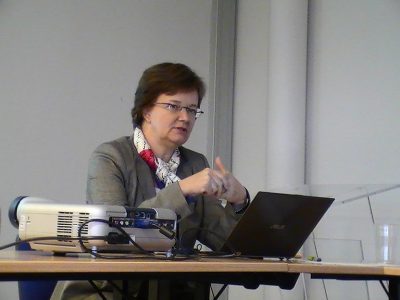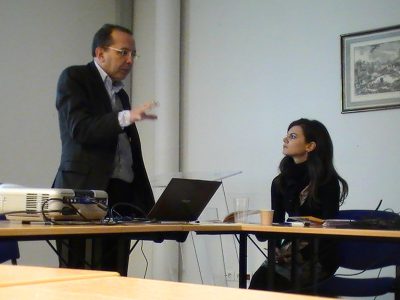The discussants presented several initiatives measuring intangibles coming from various types of organizations. These are summarized below.
“Intangible Investment in the Japanese Economy: A Sectoral Analysis.”
Tsutomu Miyagawa, Professor, Gakushuin University.
The ICT revolution accelerated growth in the US. However, other countries did not experience this increase. Intangible investment is required to enhance productivity with the use of ICT. It has long been a puzzle how, although intangible investment is high in Japan in relation to other advanced countries, productivity growth has been below these countries’ average. Economic growth has been low in Japan due to a lack of intangible investment. The gaps of investment have been progressively closing with respect to Korea.
The authors classified industries depending on their use of ICT, dividing sectors into two: ICT & non-ICT. The former has experienced superior intangible investment (software investment is double as to the non-ICT sector), and statistical evidence suggests a positive impact upon TFP growth. No conclusive evidence was found concerning this relationship in non-ICT sectors.
“Global Standards for Human Resource Management.”
Flavio Passaro, HR Advisory PBC; Hilger Pothmann, HR Director at Deutsche Bank.
This video-conference presentation discussed the role of intangibles from the Deutsche Bank perspective. Financial performance has been backwards investment. Investors are starting to look at intangibles to assess the market value in companies. The Deutsche Bank focuses on how human resources add value in companies. Specifically, it advocates efforts in measuring the effectiveness and efficiency of human resources in companies. A key question is how companies are able to retain talent? Practitioners are in need of an international standard (e.g., ISO technical standards) that allows to benchmark companies across countries.
“Public Sector Information (PSI) and Open Data: The Intellectual Capital of the Public Sector.”
Walraut Ritter, Director, Knowledge Networks and Innovation.

According to the OECD, PSI covers information created or processed by the government or any other public institution. Open Data is information that can be freely used reused and redistributed by anyone and made available in free, raw, open, standard forms that can be understood by machines and people.
USA and UK are the most active participants in Open Data. The highest proportion of traffic on the USA website comes from China, while the most attractive type of information concerns companies. Regarding PSI, information is becoming more accessible for value-creation purposes. Governments are progressively devoting efforts towards the openness of the public sector and facilitating access to data. On the other hand, there is a lack of studies on how Open Data allows the creation of economic value. Research should explore how PSI and Open Data act as resources for businesses and the civil society, enabling these to create value for the public sector.
“The measure of organizational capital: A recent OECD research.”
Marie Le Mouel, OECD
This presentation covered a OECD study on human-embodied knowledge capital. The organization proposes a task-based definition of Organizational Capial (OC). (Tasks that affect the medium to long-term functioning of a firm.) Using earnings and employment data (Occupational network database O*NET), it collected sector-wise investments at the macro level (USA). This approach reveals the importance non-managerial occupations, which make-up a significant proportion of OC investments (around 50%). While service-oriented business sectors are leading in total OC investment, manufacturing industries report higher ratios to value-added. This may be reflect how global value chains in productive activities are harder to manage.
“Towards a maturity model of Organizational Capital?”
Ahmed Bounfour, Professor, University Paris-Sud, PESOR, European Chair on Intellectual Capital Management;
Gwanaëlle Grefe, Lecturer, Angers University.

The authors introduced an approach to measuring intangibles in terms of two types of capabilities: dynamic (managing internal and external resources) and improvisation (taking quick actions based on unforeseen events). The propose a framework to build a maturity model, based on a set of capacities each of which has a five-level notation of maturity. A future survey will implement this approach to measure capabilities in firms and identify any roles in performance.